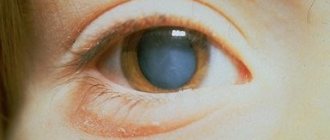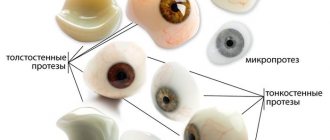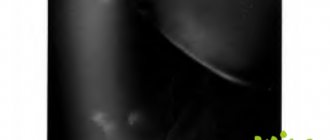When cataract extraction is performed using any of the known methods, the patient will subsequently need to have an intraocular lens (IOL) implanted or an artificial lens, which will perform the functions of the removed natural lens. And everyone who is undergoing this operation is faced with a very serious problem of choice: which lens is better, imported or domestic? Currently, various manufacturers present a fairly large number of models of intraocular lenses on the ophthalmic services market. At the same time, the cost of artificial lenses varies greatly. Therefore, it is difficult for ignorant patients to make the right choice, because they know practically nothing about the positive and negative aspects of this product.
Types of lenses for cataract surgery
Artificial lenses are divided into:
According to the material:
Hard (polymethyl methacrylate). Nowadays it is rarely used, only in cases where there are contraindications to other modern types of surgical intervention. Their installation requires incisions up to 12 mm, as well as sutures, which are removed only after six months.
Soft (acrylic, hydrogel, collamer, silicone). They are used in cataract surgery using innovative technologies using phacoemulsification. The flexibility and elasticity of the lens allows it to penetrate the anterior chamber of the eye through a tiny puncture (up to 2 mm).
By form:
Spherical, in which the light beam is scattered unevenly over the surface of the lens, resulting in glare, which significantly reduces the quality of vision.
Aspherical, in which all surface areas have the same optical power. As a result, all light rays are refracted evenly and focused at one point. This gives the image high definition without distortion.
According to the method of visual correction:
Monofocal lenses are not able to change curvature, adjusting to different distances, as happens with a natural lens. Distance vision will be corrected, but glasses will be needed for near vision.
Multifocal. The optical characteristics of the lenses resemble those of a natural lens. The complex design of the optics allows the patient, after installing such a lens, to see both far and near equally well.
Toric lenses correct vision from astigmatism due to special optics with a built-in cylinder.
Multifocal toric. They have a combined effect - they correct astigmatism, and the patient receives almost 100% vision, which he did not have before the operation.
Lenses with additional protective functions - color filters. Such models are endowed with yellow pigments that do not transmit blue rays of the invisible part of the light spectrum to the retina.
Criteria for selecting lenses
Intraocular lenses are selected by an ophthalmologist based on an assessment of the anatomical and physiological features of the structure of the patient’s organ of vision and pathological changes in the eye. To correctly select an IOL, each patient undergoes a thorough preoperative diagnosis: autorefractometry, determination of visual acuity, measurement of intraocular pressure.
When choosing a lens, the following characteristics are taken into account:
- Optical properties: light refractive ability.
- Availability of protective filters.
- IOL design: material, shape, stiffness.
- Features of the design of supporting elements.
- Reputation of the manufacturer.
When selecting IOLs, the following are taken into account: age, lifestyle, nature of professional activity, as well as the personal wishes and financial capabilities of the patient.
How to choose a lens
For each patient, lenses are selected primarily taking into account the individual parameters of the visual organs, concomitant visual pathologies and other factors influencing the choice of a particular model. All intraocular lenses used in our clinic, regardless of brand, are guaranteed to be of high quality, accurate optical characteristics and safety. From patients using domestic lenses for cataracts, reviews are as positive as those about more expensive brand lenses.
To correctly select an artificial lens, each patient undergoes a detailed examination to accurately diagnose the visual system and determine the necessary optical parameters of the intraocular lens. Using special equipment, during the examination, the exact optical parameters of the IOL are calculated, which are optimal for the patient, taking into account the characteristics of his visual organs.
Particular attention is paid to the selection of high-tech lens models with a complex optical system. These lenses include toric and multifocal IOLs. When selecting an artificial lens, many factors are taken into account:
- patient's age;
- How active the patient’s lifestyle is;
- what activities predominate in his life;
- if the patient is still working, what is his profession.
Additionally, the patient’s personal wishes regarding the properties of the lens are also taken into account in order to ensure the most comfortable life in the future with new visual sensations.
Manufacturers
American company Alcon
Numerous modifications of the brand differ in their characteristics, but what is common to the entire Alcon product line is:
- The range covers a wide range of models for both adults and children of various ages.
- The almost ideal smooth surface of the lens prevents the risk of injury to eye tissue.
- Due to the optimal design, the lens after implantation is correctly and securely located in the capsular bag.
- The chemical inertness of the IOL material ensures maximum biocompatibility with eye tissues.
- Equipping the lenses with filters against ultraviolet and blue rays.
- Implantation of intraocular lenses guarantees the patient almost 100% vision at different distances.
German company ZEISS
Lenses produced by ZEISS (Germany) are distinguished by a large assortment, affordable price, combined with excellent quality.
Advantages of the models
:
- The highest level of quality.
- The design features of the lens protect the posterior capsule of the lens from clouding.
- They have double refraction.
- Ideal biocompatibility with natural eye tissues.
- Minimal loss of photosensitivity and contrast.
- They have the ability to quickly adapt to the natural size of the pupil.
- Short recovery period.
- Low percentage of complications.
UK, Rayner
Rayner intraocular lenses are manufactured only in factories located in England, which allows for strict product quality control. A distinctive feature of these lenses is their “improved square edge” lens design, which significantly reduces the risk of developing secondary glaucoma.
Japanese lenses
Isert 251 of the Japanese corporation Hoya produces intraocular lenses from hydrophobic acrylic, which, according to the developers, will retain color, transparency and shape for at least 100 years.
Uniqueness and advantage of IOL:
- The two-piece monobloc design ensures secure fixation in the capsular bag.
- The disposable injector automatically folds the lens for implantation through a 1.8 mm opening.
- The lens implantation procedure is performed easily and safely thanks to the injector.
- The balanced aspherical profile compensates for any distortion.
Indian artificial lenses for eyes
Medical products, including intraocular lenses, from the Indian company Appasamy Ocular Devices Pvt. Ltd is a cheap alternative to well-known global brands.
The positive qualities of Indian-made IOLs include: availability, high-tech production methods. On the negative side: poor product quality, a high percentage of postoperative complications, and frequent cases of implant rejection.
Russian companies
In Russia, intraocular lenses are produced by several companies. The products are used only in the domestic market, because they are not yet able to compete with foreign analogues.
What is the difference between imported lenses and domestic ones?
Imported products from well-known brands are characterized by increased flexibility, elasticity and optimal size. They take root quickly and reliably, and the risk of miscalculations is minimal. Russian artificial lenses are inferior to their foreign counterparts in quality and many optical characteristics, but they also provide patients with good vision.
The disadvantages of domestic IOLs include significant distortion of color rendition - the presence of glare, glare, even when implanting aspheric lenses, which increases the likelihood of developing recurrent cataracts. Difficulties often arise when implanting them; they do not always provide the necessary visual acuity,
Indian lenses
The Indian company Aurolab produces Aurovue lenses. Considered as entry-level options for cataract surgery and recommended for patients on a low budget. Indian products are considered good, but significantly inferior in quality to US lenses. Akrifold 502 are registered in Russia and show good results.
| pros | Minuses |
| low cost; availability; speed of production. | low quality; often have to be replaced with a high-quality model; the risk of complications is high. |
How long will an artificial lens last?
The durability and reliability of artificial lenses is mainly determined by the nature of the material from which they are made. Previously, hard drives were used for implantation. Currently, the “gold standard” is considered to be flexible IOLs made from bioinert materials that are fully compatible with body tissues. They do not cause allergic or inflammatory reactions and are not susceptible to rejection.
The basis of intraocular lenses is a polymer that is not subject to corrosion and decay, and is inert to the effects of enzymes, acids, water and other chemicals that are present in the human body.
Modern intraocular lenses do not lose their properties over time, are durable, wear-resistant and do not need to be replaced. Therefore, the shelf life of an IOL is the entire life span of a person after installation.
According to experts from Alcon (USA), during more than 50 million operations for cataract removal with IOL installation, not a single case of complications or re-implantations associated with the quality of lenses was recorded.
How long have intraocular lenses been used?
Intraocular lenses are inserted directly into the eye. In English, intraocular is translated as “intraocular.”
In this article
- How long have intraocular lenses been used?
- Features of artificial monofocal lens
- What is an accommodating monofocal IOL?
- Advantages of multifocal artificial lenses
- Aspheric IOLs for cataracts
- Which artificial lens manufacturer should I choose?
Separately, intro means “introduction,” and ocular means “visual.” The literal translation of the medical term allows anyone to form an unmistakable opinion about what an IOL is. The intraocular lens should coexist “peacefully” with the surrounding ocular tissues, especially with the lens capsule, which is the main membrane formed from epithelial cells. Surgery is the only way to overcome an ophthalmological disease such as cataracts. In fact, surgical intervention is the replacement of a clouded lens with an artificial one, that is, an intraocular lens. Removal of the lens, which has lost its opacity due to cataracts, and implantation of IOLs are carried out today throughout the world. For the first time, this method of combating ophthalmic disease was proposed by ophthalmological surgeon from Great Britain Harold Ridley. In 1949, he was the first among his colleagues to replace the clouded lens with an intraocular lens. In those years, the surgical technique was not well developed, and therefore the first implantations were quite painful for patients. But the main thing is that the principle of replacing the lens has proven itself well, so this method of treatment has been further developed. In our country, the patent for the creation of the first IOL belongs to two scientists at the same time. They were the famous ophthalmologist Svyatoslav Fedorov and his Arkhangelsk colleague Valery Zakharov. In 1962, they introduced the first intraocular lens in the USSR, which for many years was considered the best among artificial lenses throughout the world.
But still, the very first IOL was manufactured by a technologist-pattern, one of the leaders in the production of the Cheboksary Electrical Equipment Plant, Semyon Milman. However, he was only a performer. The idea of creating such a device belonged to Svyatoslav Fedorov. The lens was made of plastic and was implanted in a guinea pig in 1959.









